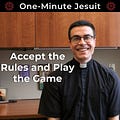In his classic Orthodoxy, G.K. Chesterton compares Catholic doctrine and discipline to the walls of a playground near the edge of a cliff. If there is a fence around the playground, children can play freely. Without walls, there is no play. Absolute caution is necessary. With a fear of falling, joy ceases. Only with some guardrails can people have freedom to move around and enjoy themselves. Chesterton continues:
“The unpopular parts of Christianity turn out when examined to be the very props of the people. The outer ring of Christianity is a rigid guard of ethical abnegations and professional priests; but inside that inhuman guard you will find the old human life dancing like children and drinking wine like men.”
As a Catholic priest—and a fan of dancing and wine!—it’s no surprise that I think Chesterton is on to something. Still, many of the dynamics that Chesterton describes are not unique to Christianity. Total freedom leaves us floundering. We need collective wisdom. We need direction. We need rules.
If there were no limitations on how and when a defensive end could hit a quarterback, things would soon get ugly. If there were no penalties for going out of bounds in a sport, then there would be no effort to stay within the lines (and no heated arguments about whether the player’s foot was in). Fans would soon lose interest.
Accepting the rules can lead to the beauty of the game:


